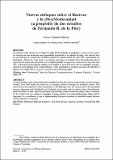Por favor, use este identificador para citar o enlazar a este item:
http://hdl.handle.net/10261/12945COMPARTIR / EXPORTAR:
 SHARE
BASE SHARE
BASE
|
|
| Visualizar otros formatos: MARC | Dublin Core | RDF | ORE | MODS | METS | DIDL | DATACITE | |

| Campo DC | Valor | Lengua/Idioma |
|---|---|---|
| dc.contributor.author | Cornago Bernal, Óscar | es_ES |
| dc.date.accessioned | 2009-05-08T10:59:16Z | - |
| dc.date.available | 2009-05-08T10:59:16Z | - |
| dc.date.issued | 2004 | - |
| dc.identifier.citation | Dicenda: Cuadernos de filología hispánica, 22: 27-51 (2004) | es_ES |
| dc.identifier.issn | 0212-2952 | - |
| dc.identifier.uri | http://hdl.handle.net/10261/12945 | - |
| dc.description | Este artículo está sujeto a una licencia CC BY 4.0 | es_ES |
| dc.description.abstract | [ES] La reflexión sobre el Barroco a lo largo del siglo XX ha definido un imaginario y una serie de corrientes teóricas que han alcanzado una sorprendente actualidad en las últimas décadas. Este artículo hace un recorrido por la recuperación del Barroco desde la segunda mitad del siglo XIX, comenzando con Buckhardt y Nietzsche, hasta llegar a las últimas posiciones en el debate de la Posmodernidad. En el marco de este abigarrado panorama, con un reflejo palpable en numerosos escritores a lo largo del siglo XX, se discuten los dos últimos estudios de Fernando R. de la Flor acerca de las estrategias de representación en la España de la Contrarreforma. Como conclusión se propone un modo de entender el Barroco en el siglo XX en relación a las teorías de la Posmodernidad. | es_ES |
| dc.description.abstract | [EN] A whole imagery and a series of theoretical tendencies, that have become surprisingly current in recent decades, have been shaped by reflection on Baroque aesthetics through the twentieth century. This article traces the trajectory of the recuperation of the Baroque from the second half of the nineteenth century, beginning with Buckhardt and Nietzsche and ending with the debate about Posmodernity. Inside the frame of this clustered panorama, that includes several twentieth-century writers, Fernando R. de la Flor’s last two studies on strategies of representation in Counter-Reformation Spain will be discussed. As a conclusion, a way of understanding Baroque in relation to twentieth-century theories of Posmodernity is proposed. | es_ES |
| dc.format.extent | 504458 bytes | - |
| dc.format.mimetype | application/pdf | - |
| dc.language.iso | spa | es_ES |
| dc.publisher | Universidad Complutense de Madrid | es_ES |
| dc.relation.isversionof | Publisher's version | es_ES |
| dc.rights | openAccess | es_ES |
| dc.subject | Modernidad | es_ES |
| dc.subject | Teoría del Barroco | es_ES |
| dc.subject | Posestructuralismo | es_ES |
| dc.subject | Literatura Española | es_ES |
| dc.subject | 2ª mitad Siglo XX | es_ES |
| dc.subject | Modernity | es_ES |
| dc.subject | Baroque Aesthetics | es_ES |
| dc.subject | Post-Structuralism | es_ES |
| dc.subject | Spanish Literature | es_ES |
| dc.subject | Second Half 20th Century | es_ES |
| dc.title | Nuevos enfoques sobre el Barroco y la (Pos)Modernidad (a propósito de dos estudios de Fernando R. de la Flor) | es_ES |
| dc.type | artículo | es_ES |
| dc.description.peerreviewed | Peer reviewed | es_ES |
| dc.relation.publisherversion | https://revistas.ucm.es/index.php/DICE/article/view/DICE0404110027A | es_ES |
| dc.rights.license | https://creativecommons.org/licenses/by/4.0/ | es_ES |
| dc.relation.csic | Sí | es_ES |
| dc.contributor.orcid | Cornago Bernal, Óscar [0000-0002-3660-6392] | es_ES |
| dc.type.coar | http://purl.org/coar/resource_type/c_6501 | es_ES |
| item.openairetype | artículo | - |
| item.grantfulltext | open | - |
| item.cerifentitytype | Publications | - |
| item.openairecristype | http://purl.org/coar/resource_type/c_18cf | - |
| item.fulltext | With Fulltext | - |
| item.languageiso639-1 | es | - |
| Aparece en las colecciones: | (CCHS-ILLA) Artículos | |
Ficheros en este ítem:
| Fichero | Descripción | Tamaño | Formato | |
|---|---|---|---|---|
| DICE0404110027A.pdf | 492,63 kB | Adobe PDF |  Visualizar/Abrir |
CORE Recommender
Page view(s)
628
checked on 19-abr-2024
Download(s)
543
checked on 19-abr-2024
Google ScholarTM
Check
Este item está licenciado bajo una Licencia Creative Commons

